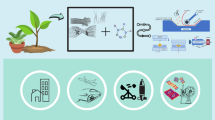The Taguchi method was used to determine the optimum content of a four-parameters cellulose fiber pulp, polyvinyl alcohol (PVA) fibers, a silica fume, and bentonite for cement-based composite sheets. Then cement composite sheets from the hybrid of PVA and the cellulose fiber pulp were manufactured, and their moduli of rapture were determined experimentally. The result obtained showed that cement composites with a hybrid of PVA and cellulose fiber pulp had a higher flexural strength than cellulose-fiber- reinforced cement ones, but this strength was rather similar to that of asbestos-fiber-reinforced cement composites. Also, using the results of flexural tests and an analytical method, the tensile and compressive moduli of the hybrid of PVA and cement sheet were calculated. The hybrid of PVA and cellulose fiber pulp is proposed as an appropriate alternative for substituting asbestos in the Hatschek process.






Similar content being viewed by others
References
M. Jamshidi and A. A. Ramezanianpour, “Laboratory and industrial investigations of hybrid of acrylic and glass short fibers as an alternative for substituting asbestos in the Hatschek process,” Construction and Building Materials, 25, No. 1, 298–302 (2011).
Andrzej M. Brandt, “Fibre-reinforced cement-based (FRC) composites after over 40 years of development in building and civil engineering,” Composite Structures, 86, No.1, 3–9 (2008).
Pierre Delvaux, Normand Lesmerises, and Luc Desrosiers, “Process for manufacturing a composite material,” U.S. Patent No. 5, 076, 986, 31 Dec. 1991.
S. Ikai, J. R. Reichert, A. R. Vasconcellos, and V. A. Zmapieri, “Asbestos-free technology with new high tenacity PP–polypropylene fibers in air-cured Hatschek process,” 10th Int. Inorganic-bonded Fiber Composites Conf. (Iibcc 2006).
Robert S. P. Coutts, “A review of Australian research into natural fibre cement composites,” Cement and Concrete Composites, 27, No. 5, 518–526 (2005).
Antoine E. Naaman and El-Tawil Sherif, “Comparative flexural behavior of four fiber-reinforced cementitious composites,” Cement and concrete Composites, 30, No. 10, 917–928 (2008).
M. A. Mansur and M. A. Aziz, “A study of jute-fibre-reinforced cement composites,” Int. J. of Cement Composites and Lightweight Concrete, 4, No. 2, 75–82 (1982).
H. Savastano Jr, P. G. Warden, and R. S. P. Coutts, “Brazilian waste fibers as reinforcement for cement-based composites,” Cement and Concrete Composites, 22, No. 5, 379–384 (2000).
D. D. L. Chung, “Cement reinforced with short carbon fibers: a multifunctional material,” Composites Part B: Engineering, 31, No. 6, 511–526 (2000).
Amal J. Majumdar and R. W. Nurse, “Glass fibre reinforced cement,” Materials Science and Engineering, 15, No. 2, 107–127 (1974).
M. A. Mansur and M. A. Aziz, “A study of jute-fibre-reinforced cement composites,” Int. J. of Cement Composites and Lightweight Concrete, 4, No. 2, 75–82 (1982).
ACI. Report on Fiber Reinforced Concrete, 2002: PP 56, 544.1R-96
Banthia, Nandakumar, and N. Nandakumar, “Crack growth resistance of hybrid-fiber-reinforced cement composites,” Cement and Concrete Composites, 25, No. 1, 3–9 (2003).
M. Roger Rixom and Noel P. Mailvaganam, Chemical Admixtures for Concrete, Taylor & Francis, 1999.
M. Khorami and E. Ganjian, “Comparing flexural behavior of fiber-cement composites reinforced bagasse: Wheat and eucalyptus,” Construction and Building Materials, 25, No. 9, 3661–3667 (2011).
R. K. Roy, Primer on the Taguchi Method, 2nd ed., 2010, Society of Manufacturing Engineers.
T. R. Lin, “Experimental design and performance analysis of TiN-coated carbide tool in face milling stainless steel,” J. Mater. Process Technol., 127, 1–7 (2002).
A. K. Lakshminarayanan and V. Balasubramanian, “Process parameters optimization for friction stir welding of RDE-40 aluminum alloy using Taguchi technique,” Trans. Nonferrous Met. Soc. China, 18, 548–554 (2008).
F. Mujika, N. Carbajal, A. Arrese, and I. Mondragon, “Determination of tensile and compressive moduli by flexural tests,” Polymer Testing, 25, 766–771 (2006).
Author information
Authors and Affiliations
Corresponding author
Additional information
Russian translation published in Mekhanika Kompozitnykh Materialov, Vol. 51, No. 2, pp. 329–340 , March-April, 2015.
Rights and permissions
About this article
Cite this article
Shokrieh, M.M., Mahmoudi, A. & Shadkam, H.R. Hybrid Polyvinyl Alcohol and Cellulose Fiber Pulp Instead of Asbestos Fibers in Cement-Based Composites. Mech Compos Mater 51, 231–238 (2015). https://doi.org/10.1007/s11029-015-9494-7
Received:
Revised:
Published:
Issue Date:
DOI: https://doi.org/10.1007/s11029-015-9494-7




